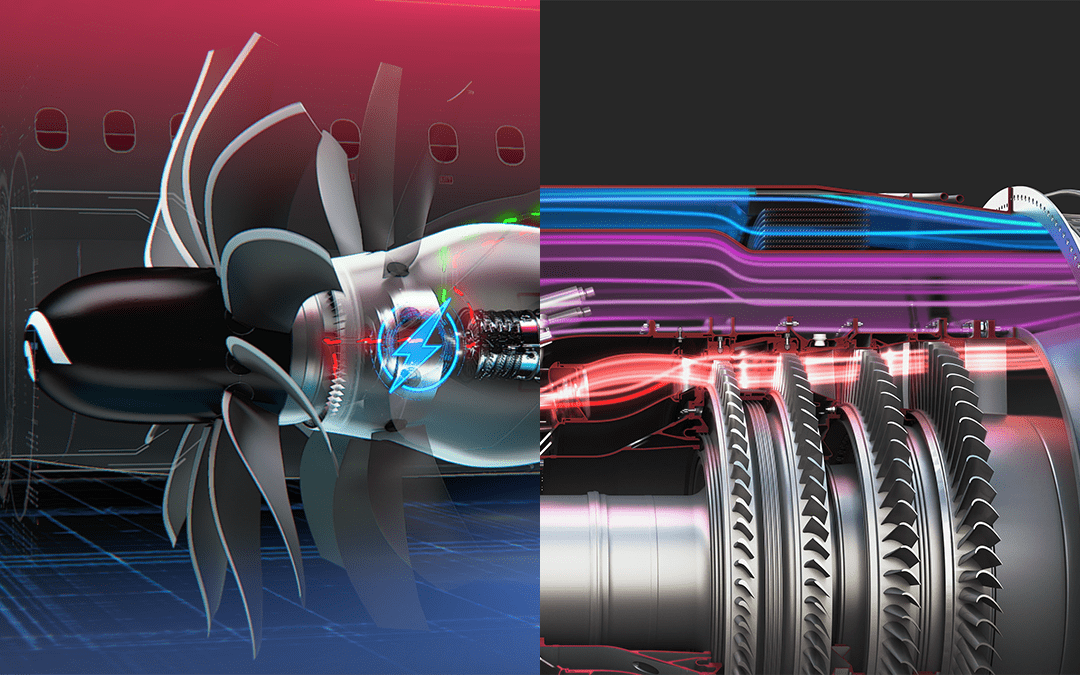GE Aerospace’s 2022 Technology Announcements to Help Accelerate a More Sustainable Future of Flight
December 21, 2022 | by Chelsey Levingston
As 2022 quickly comes to a close, it marks another major year in technology for GE Aerospace. The company looks to mature new, breakthrough technologies that could eventually lead to aircraft engine products with reduced CO2 emissions compared to engines today.
“We have one of the most robust pipelines of innovation in the company’s history, which will continue to position GE Aerospace as an industry leader in the decades to come,” said Mohamed Ali, vice president of engineering for GE Aerospace.
Since CFM International, a 50-50 joint company between GE and Safran Aircraft Engines, first unveiled in 2021 the RISE (Revolutionary Innovation for Sustainable Engines) program, plans were shared this year to flight test a hydrogen combustion engine and the open fan architecture with Airbus. The goal of CFM’s RISE program is to mature multiple technologies to achieve at least 20% better fuel efficiency and 20% fewer CO2 emissions compared to the most efficient engines today. Advanced engine architectures, such as the open fan, hybrid electric capability, compact engine core designs and compatibility with alternative fuels are all being developed through the RISE program.

GE Aerospace’s engineering teams also continue to advance more electric propulsion, achieving this year the world’s first high power, high voltage test of hybrid electric components in simulated altitude. The test of the integrated system — including electric motor/generators, power converters, power transmission and power control systems — successfully demonstrated performance and operation of the components in a replicated flight environment. The Electrified Powertrain Flight Demonstration (EPFD) project with NASA and Boeing aims to fly a megawatt-class hybrid electric propulsion system in the middle of this decade. A European consortium led by Avio Aero, part of the GE Aerospace business, has also launched the AMBER hybrid electric technology demonstrator that will explore integration with hydrogen fuel cells.
Hybrid electric propulsion technologies can help improve engine performance, reducing fuel usage and emissions.
New military engine technology developments include the world’s first three-stream, adaptive cycle engine, the XA100, designed by the Edison Works team for the F-35 Lightning II under the U.S. Air Force Adaptive Engine Transition Program (AETP). This engine flexes to provide more fuel-efficient flight for cruise compared to today’s engines and high-power for combat. Testing was successfully concluded this year on the second XA100 adaptive cycle engine, completing all major AETP contract milestones and proving 30% more range, 20% greater acceleration and two times the thermal management capacity compared with the current engine that powers the F-35.
“Our engineering team continues to develop cutting-edge technology to support armed forces,” said Darin DiTommaso, vice president of engineering for GE’s Edison Works. “The XA100 engine is the first of its kind and another example of how we continue to help invent the future of flight.”

Meanwhile, the U.S. Army also successfully concluded testing on the first T901 development engine in 2022. The T901 is GE’s next-generation rotorcraft engine — with 25% better specific fuel consumption than its predecessor — that will power the U.S. Army’s UH-60 Black Hawk, AH-64 Apache and Future Attack Reconnaissance Aircraft (FARA) aircraft in the future.
Establishing GE Aerospace’s Advanced Research Center will also continue to put innovation at the forefront.
“Our research center capabilities are an important part of GE’s heritage and will be an important part of our future as we look to continue redefining flight for future generations,” Ali said.
Learn more about these efforts in the video interview below with Ali and Farnborough International News Network:
“We have one of the most robust pipelines of innovation in the company’s history, which will continue to position GE Aerospace as an industry leader in the decades to come,” said Mohamed Ali, vice president of engineering for GE Aerospace.
Since CFM International, a 50-50 joint company between GE and Safran Aircraft Engines, first unveiled in 2021 the RISE (Revolutionary Innovation for Sustainable Engines) program, plans were shared this year to flight test a hydrogen combustion engine and the open fan architecture with Airbus. The goal of CFM’s RISE program is to mature multiple technologies to achieve at least 20% better fuel efficiency and 20% fewer CO2 emissions compared to the most efficient engines today. Advanced engine architectures, such as the open fan, hybrid electric capability, compact engine core designs and compatibility with alternative fuels are all being developed through the RISE program.

GE Aerospace’s engineering teams also continue to advance more electric propulsion, achieving this year the world’s first high power, high voltage test of hybrid electric components in simulated altitude. The test of the integrated system — including electric motor/generators, power converters, power transmission and power control systems — successfully demonstrated performance and operation of the components in a replicated flight environment. The Electrified Powertrain Flight Demonstration (EPFD) project with NASA and Boeing aims to fly a megawatt-class hybrid electric propulsion system in the middle of this decade. A European consortium led by Avio Aero, part of the GE Aerospace business, has also launched the AMBER hybrid electric technology demonstrator that will explore integration with hydrogen fuel cells.
Hybrid electric propulsion technologies can help improve engine performance, reducing fuel usage and emissions.
New military engine technology developments include the world’s first three-stream, adaptive cycle engine, the XA100, designed by the Edison Works team for the F-35 Lightning II under the U.S. Air Force Adaptive Engine Transition Program (AETP). This engine flexes to provide more fuel-efficient flight for cruise compared to today’s engines and high-power for combat. Testing was successfully concluded this year on the second XA100 adaptive cycle engine, completing all major AETP contract milestones and proving 30% more range, 20% greater acceleration and two times the thermal management capacity compared with the current engine that powers the F-35.
“Our engineering team continues to develop cutting-edge technology to support armed forces,” said Darin DiTommaso, vice president of engineering for GE’s Edison Works. “The XA100 engine is the first of its kind and another example of how we continue to help invent the future of flight.”

Meanwhile, the U.S. Army also successfully concluded testing on the first T901 development engine in 2022. The T901 is GE’s next-generation rotorcraft engine — with 25% better specific fuel consumption than its predecessor — that will power the U.S. Army’s UH-60 Black Hawk, AH-64 Apache and Future Attack Reconnaissance Aircraft (FARA) aircraft in the future.
Establishing GE Aerospace’s Advanced Research Center will also continue to put innovation at the forefront.
“Our research center capabilities are an important part of GE’s heritage and will be an important part of our future as we look to continue redefining flight for future generations,” Ali said.
Learn more about these efforts in the video interview below with Ali and Farnborough International News Network:





